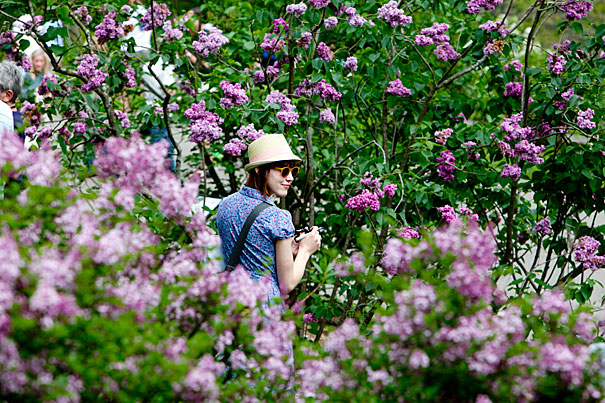
Anna Marden, of Boston, takes pictures as Harvard’s Arnold Arboretum celebrated its 104th Lilac Sunday with tours and other activities.
Rose Lincoln/Harvard Staff Photographer
Splendid acres
Lilac Sunday a colorful introduction to the Arboretum’s offerings
Jamaica Plain resident Elaine Saint and her family were among thousands of visitors who wandered the colorful collections of Harvard’s Arnold Arboretum on Lilac Sunday.
“I’ve lived in Jamaica Plain for about six years, but this was my first visit to the Arnold Arboretum,” she said. “I had such a wonderful morning with my kids, Kingston and Khalesi, and it was great to be surrounded by so many other families enjoying the day.”
Now in its 104th year, Lilac Sunday has become a time-honored tradition for families to celebrate Mother’s Day at the Arboretum, which boasts more than 15,000 woody plants on its 265-acre landscape. This year, the event included tours of the Arboretum’s other collections, including the Bradley Rosaceous Collection, the Leventritt Shrub and Vine Gardens, and the Explorers Garden.
Maggie Redfern, Explorers Garden tour guide and visitor education assistant, said the day was an opportunity to connect with multiple generations of Bostonians, some of whom were new to the Arboretum. “Half the people on my tour had never been here before,” Redfern said. “We had two teenage girls in our group, as well as their mother and grandmother.”
It’s that opportunity to encourage lifelong learning, and expand the understanding of the Arboretum in the community, that William “Ned” Friedman, director of the Arnold Arboretum and Arnold Professor of Organismic and Evolutionary Biology, finds so rewarding.
“It’s incredibly important for the Arnold Arboretum of Harvard University to be much more than a collection to come and look at,” Friedman said. “We are part of a university whose mandate is to share and educate with all of the incredible resources that Harvard can bring to bear. We’d like our visitors to learn more about the evolution that underpins all modern biology, the dangers of invasive species that can destroy entire ecosystems, as well as benefit from the aesthetics of our biodiversity collections. Our evening public lectures, guided tours, volunteers, and scientists are central to sharing our unique resources and insights with our neighbors of all ages in the Greater Boston area and beyond.”
Julie Warsowe, manager of visitor education at the Arboretum, agreed. “Beyond Lilac Sunday, we want to reach a broad audience. We have fun science activities for families, interpreters in the landscape who can help visitors learn more about plants – we want to reach all those casual visitors who may have come for a social experience, and give them the opportunity to connect and have a deeper, richer, and more informative experience.”
To that end, the Arboretum has launched several new programs to engage and educate the community. Two mobile applications provide information on many of the Arboretum’s trees. Next month, the Arboretum will roll out a new international month program, which will provide tours of the living collections in 10 languages. The Arboretum has also launched a “tree mob” program offering 15-minute lessons on its amazing organisms.
The initiatives, Friedman said, are all “part of our effort to exceed expectations and surprise. When you come to the Arboretum, whatever you were expecting, we want you to get even more.”
Saint’s first Lilac Sunday made such an impression that she’s already considering options for the 105th celebration next year. “I might even start a tradition of having a picnic with other moms and their families,” she said. “I’ll definitely come back.”




